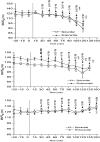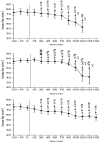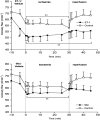Electrophysiological and haemodynamic effects of endothelin ETA and ETB receptors in normal and ischaemic working rabbit hearts
- PMID: 15980873
- PMCID: PMC1576251
- DOI: 10.1038/sj.bjp.0706304
Electrophysiological and haemodynamic effects of endothelin ETA and ETB receptors in normal and ischaemic working rabbit hearts
Abstract
The aims of this study were to determine if endothelin-1 (ET-1) under normal and ischaemic conditions exhibits a direct arrhythmogenic effect that is independent of its ability to cause coronary vasoconstriction, and to determine the contribution of the ET(A) and ET(B) receptor subtype. ET(A/B) (with ET-1) and ET(A) (ET-1 in the presence of BQ-788) receptor activation resulted in a significant reduction in both epi- and endocardial monophasic action potential duration (MAPD(90)). ET(A) receptor activation reduced both epi- and endocardial effective refractory period (ERP). This MAPD(90) and ERP shortening were associated with a reduction in coronary flow, myocardial contractility and induction of ventricular fibrillation (VF) during ERP measurement. The ET(B) agonist sarafotoxin (S6c) had no marked, or concentration-dependent, effect on MAPD(90), ERP, myocardial contractility or induction of arrhythmias. Neither ET-1 nor S6c, given prior to coronary artery occlusion, significantly changed the ischaemia-induced dispersion of MAPD(90), ERP or the % incidence of VF. In conclusion, neither ET(A) nor ET(B) receptor stimulation has a direct arrhythmogenic effect in isolated rabbit hearts under normal or ischaemic conditions. The ET-1-induced arrhythmogenic effect observed in nonischaemic hearts is likely to be the result of the associated coronary vasoconstriction caused by ET(A) receptor stimulation resulting in myocardial ischaemia.
Figures







Similar articles
-
Do endothelin receptor antagonists have an antiarrhythmic potential during acute myocardial infarction? Evidence from experimental studies.J Interv Card Electrophysiol. 2010 Sep;28(3):157-65. doi: 10.1007/s10840-010-9493-5. Epub 2010 Jun 8. J Interv Card Electrophysiol. 2010. PMID: 20532602 Review.
-
Activation of endothelin ETA receptors masks the constrictor role of endothelin ETB receptors in rat isolated small mesenteric arteries.Br J Pharmacol. 1997 Apr;120(7):1376-82. doi: 10.1038/sj.bjp.0701036. Br J Pharmacol. 1997. PMID: 9105715 Free PMC article.
-
Cardiovascular and renal actions of the endothelin(B) receptor in pigs.J Cardiovasc Pharmacol. 1997 Jun;29(6):704-12. doi: 10.1097/00005344-199706000-00002. J Cardiovasc Pharmacol. 1997. PMID: 9234650
-
Endothelin B receptor-mediated vasoconstriction induced by endothelin A receptor antagonist.Cardiovasc Res. 1998 Sep;39(3):665-73. doi: 10.1016/s0008-6363(98)00152-7. Cardiovasc Res. 1998. PMID: 9861310
-
Endothelin and the ischaemic heart.Curr Vasc Pharmacol. 2005 Oct;3(4):333-41. doi: 10.2174/157016105774329417. Curr Vasc Pharmacol. 2005. PMID: 16248776 Review.
Cited by
-
Do endothelin receptor antagonists have an antiarrhythmic potential during acute myocardial infarction? Evidence from experimental studies.J Interv Card Electrophysiol. 2010 Sep;28(3):157-65. doi: 10.1007/s10840-010-9493-5. Epub 2010 Jun 8. J Interv Card Electrophysiol. 2010. PMID: 20532602 Review.
References
-
- BECKER R., MERKELY B., BAUER A., GELLER L., FAZEKAS L., FREIGANG K.D., VOSS F., SENGES J.C., KUEBLER W., SCHOELS W. Ventricular arrhythmias induced by endothelin-1 or by acute ischaemia: a comparative analysis using three-dimensional mapping. Cardiovasc. Res. 2000;45:310–320. - PubMed
-
- BEYER M.E., HOVELBORN T., DELEBAR U., HOFFMEISTER H.M. Significance of the endothelin A receptor for the haemodynamic and inotropic effects of endothelin-1 in rats. Clin. Sci. 2004;107:467–475. - PubMed
-
- CROCKETT T.R., SHARIF I., KANE K.A., WAINWRIGHT C.L. Sarafotoxin 6c (S6c) protects against ischaemia-induced cardiac arrhythmias in vivo and in vitro in the rat. J. Cardiovasc. Pharmacol. 2000;36 Suppl 1:S297–S299. - PubMed
-
- DOWNAR E., JANSE M.J., DURRER D. The effect of ‘ischemic' blood on transmembrane potentials of normal porcine ventricular myocardium. Circulation. 1977;55:455–462. - PubMed
-
- DURU F., BARTON M., LUSCHER T.F., CANDINAS R. Endothelin and cardiac arrhythmias: do endothelin antagonists have a therapeutic potential as antiarrhythmic drugs. Cardiovasc. Res. 2001;49:272–280. - PubMed
Publication types
MeSH terms
Substances
LinkOut - more resources
Full Text Sources

